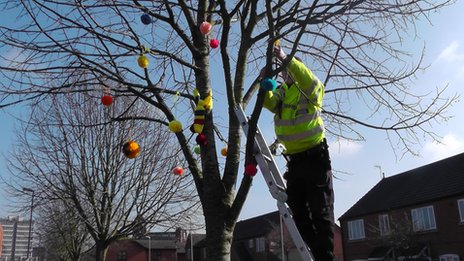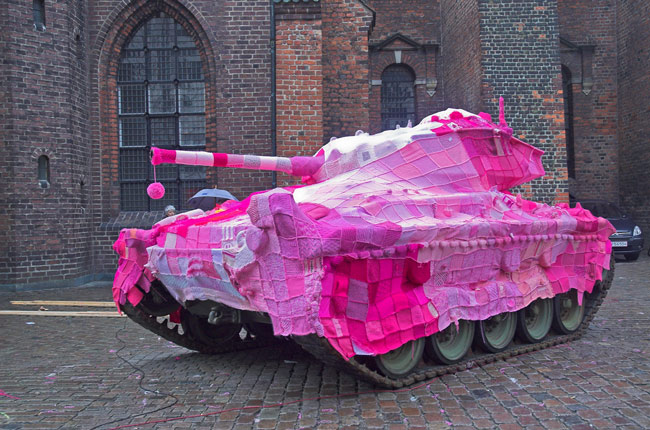I’ve been wanting to write about the awesome practice of yarnbombing since beginning this blog. If you’ve never heard of yarnbombing (also called yarnstorming), it’s basically the crafty equivalent of graffiti, done with yarn and needles rather than paint. Renegade crafters head out, usually under cover of dark, and cover signposts, parking meters, benches, bike racks and other urban structures with colorful knitted or crocheted yarn. Extreme yarnbombers have taken it even further, covering entire cars, buildings and statues with yarn.
Like any public art, yarnbombing certainly beautifies neighborhoods, at least temporarily. But can it effect social change? It’s certainly not fighting poverty, hunger, or poor health. But it does get people to pay attention to their surroundings in a way they normally wouldn’t. It brings some brightness to drab, cement landscapes and makes people smile.
One community in the UK is putting up yarn installations to deter crime, or at least reduce residents’ fears of crime. Police and neighborhood associations have decorated trees and lampposts with yarn baubles, in the hopes that it will make public spaces more inviting and encourage residents to spend more time out and about in their communities. Building on the “broken windows” theory, they hope that by making the area look more pleasant and taken-care-of, people will be less likely to commit vandalism or other crimes. Art (or craft) in public spaces is one way to achieve this.
Renegade crafters have also used yarnbombing to make expressly political statements. A group of environmental activists in Alberta wanted to raise awareness of natural areas in their province that are being destroyed, so they yarnbombed a forest that was slated for logging. Danish artist Marianne Jorgenson entirely covered an historic military tank with pink, knitted and crocheted squares to protest Denmark’s involvement in the Iraq war. If you had to think of something that was antithetical to a violent war, a pink, fuzzy blanket would probably be high on the list.
In all these uses of yarnbombing, whether for a political purpose or just for fun, the yarn has symbolic connotations of warmth, love and comfort. Like a baby blanket or an afghan your grandmother made for you, it’s something cozy and inoffensive, an antidote to oppressive urban sprawl or abandoned neighborhoods.
If you want to learn more about yarnbombing, a new fiber arts center, Baltimore Threadquarters, is hosting two yarnbombing workshops this Friday and Saturday. Check them out and get knitting!





Also, our city’s man-woman statue is literally crying out for yarn bombing:
https://twitter.com/manwomanstatue/status/294105655973920768
I’d love to collaborate with someone on making this happen =)
I love this! Making people stop and think if only for a minute is a change. Over time those minutes can add up to real time and real change.
[…] and Guerilla Crafting make public comments on social issues. The world is returning to the creative hands of artisans: […]